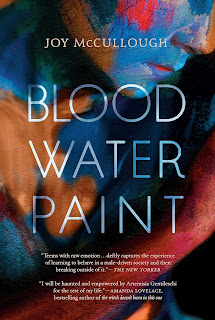Blood Water Paint
by Joy
McCullough
Reading a
biographical book in verse from the perspective of Artemisia Gentileschi was
very unusual. I did not know her story prior to picking up the book and this
telling of it is decidedly dark in nature, as befits what she went through.
The story
is told in poetry, some of it in the perspective of Artemisia Gentileschi during
her late teen years and some during her childhood at her mother’s knee, while
her mother recounts historical stories to educate Artemisia about what it means
to be a woman at that time.
“She knew
I’d need Susanna
when I
found myself
a woman in
a world of men.
Girl as
prey.”
Artemisia
works for her father in his studio, painting many of the works commissioned by
others, but it is his name, not hers, that is signed on the paintings. Very few
have any idea that she is the painter.
“No: the
painter merely signs his name
and takes
his gold.”
Artemisia’s
father is volatile, often drunk, and derogatory toward Artemisia.
“What is that ridiculous
expression
on her face?
I redirect
my eye
to the
Madonna’s face.
He is my
teacher, after all,
for what
he’s worth
(not much).”
At the
same time she is required to paint, or at least fix, her father’s commissions,
she is also having to put up with his derision, and help the housekeeper clean
and go to market, and prepare food. Her younger brothers are only required to
do their school lessons, something Artemisia has never really had.
Then her
father brings home another painter, Agostino Tassi, who has a large commission
and will need other painters to work with him. Artemisia’s father is hoping she
can convince him to bring her father on board as one of those painters. From
the first moment she meets him, Artemisia is smitten by him, praying that he
might fall in love with her and take her away from her menial existence. The
author portrays him as intelligent, handsome, and kind. We quite like him,
until he demands more than Artemisia is willing to give.
This is
one of those places where the story diverges to some degree with the biographies
found online. Here, Artemisia gets to know him, trusts him, he acts as a mentor
in her painting, and then he betrays that trust.
In the
biography I read online, she barely knew who he was. He and a friend were
merely let in by the housekeeper, seemingly with the express purpose of taking
advantage of Artemisia. Her father is out, and the housekeeper has been bribed
to turn a blind eye.
As I said,
this is a dark story. One wants to say pessimistic but the court records show
that to some degree, it is an accurate and painful one, though artistic license
is taken in the story arc. It is beautifully written but a wrenching story,
that left me a good bit nauseous.
Still,
Artemisia wins her court case, she survives, and becomes one of the best
painters of her time. She also becomes the first woman to become a member of
the Accademia di Arte del Disegno in Florence. Her
story has been portrayed many times in both literature and stage.
The prose
is very easy to read, clear and compact, words chosen carefully for maximum
impact. McCullough makes judicious use of spacing to indicate the reading,
through line breaks and tab spaces. Punctuation is minimal but traditionally
used. Broken up into 100 “chapters” – each chapter is either a short poem, the
equivalent of a few sentences, or a more traditional paragraph, still lyrical
in nature.
I would
recommend this for its’ literary qualities, but with reservations based on the
content.

No comments:
Post a Comment